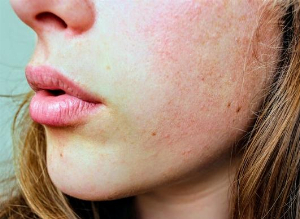How to face the cold with atopic dermatitis?
Published 7 Dec 2020 • By Candice Salomé
Atopic dermatitis is a chronic inflammatory skin disease. It usually develops in infants and children but can persist or appear in adolescents or adults. Atopic dermatitis is characterised by dry skin associated with eczema-like lesions that develop in flare-ups. In winter, the cold and wind are can further irritate this highly sensitive skin.
So what are the symptoms of atopic dermatitis? Why does it worsen during winter? How do you treat atopic dermatitis made worse by the cold? What advice should you put into practice to face the winter?
This article will tell you everything!

What is atopic dermatitis?
Atopic dermatitis (also called atopic eczema) is a chronic inflammatory skin condition. This non-contagious conditions causes itchiness and develops flares.
Common symptoms of atopic dermatitis are:
- Xerosis (dry skin)
- Pruritus (itchy skin)
- Rashes
- Oozing plaques on the skin
- Vesicular lesions (small blisters)
- Thickening of the skin, and sometimes, crusts and oedema
Atopic eczema develops in infants, usually after 3 months of age. Lesions can appear on the rounded areas of the face and limbs, on the scalp and on the buttocks.
Later on, these lesions can be found in skin folds (behind the knees, elbows and in the neck), on the hands and around the mouth.
Most cases of atopic dermatitis usually disappear during childhood (50% before the age of 5), but 10 to 15% of cases persist into adulthood.
According to studies, 50 to 70% of children with atopic dermatitis have a first degree relative (parent, brother or sister) who has atopic dermatitis his or herself.
Atopic dermatitis results from both cutaneous and immunological anomalies that are genetically transmitted:
- The patient secretes a high quantity of IgE antibodies in response to allergens (animal hair, pollens, dust mites, etc.)
- Atopic skin is dry and lacks a natural protective hydrolipidic film. This absence allows allergenic molecules to penetrate the epidermis and to come into contact with the skin's immune defence cells. An inappropriate inflammatory response is then triggered and the symptoms of atopic dermatitis appear.
Why does eczema worsen during winter?
During winter, cold and dry weather are important triggering factors for atopic eczema, and cause the skin to dry out quickly. This is followed by an impaired barrier function of the skin, which can intensify and lead to infection.
This is not only true for people with atopic dermatitis. The human epidermis is covered with a very thin hydrolipidic film that forms a protective barrier. This hydrolipidic film is made of water and lipids. Its composition varies according to the areas of the body, age and hormones, but also according to certain external factors: temperature, personal hygiene or the types of products applied to the skin.
These changes in the composition of the hydrolipidic film of the stratum corneum (the top layer of the skin which acts as a barrier) cause the itching that is all too well known for patients with atopic dermatitis.
In winter, these changes are due to seasonal changes in the environment: the cold outside, but also the heating inside which makes the air drier. This leads to dehydration of the epidermis.
For atopic skin, which is greatly exacerbated in winter, local antibiotics and treatments are required which can cause temporary sensitisation and discomfort. It is therefore is important to apply emollient to atopic skin on a constant basis. Certain treatments can also be prescribed in case of obvious lesions.
Short, lukewarm showers are recommended (not higher than 35°C, because dry skin cannot tolerate hot water). Specific shower gels should also be used: liquid syndet soaps (short for "synthetic detergent" or non-soap cleanser, which are designed to be less irritating to the skin) or an ultra-rich lipid-restoring bar.
Finally, the skin must be protected from the cold before going outside: gloves and a scarf made of natural fibres should be worn, and an emollient cream should be applied on the face.
How to treat atopic dermatitis that has been aggravated by the cold weather?
If the stage and clinical aspect of atopic dermatitis symptoms are advanced, you should make an appointment with your dermatologist. A treatment will be determined. The protocol is based on local corticosteroids or calcineurin inhibitors (ciclosporin or tacrolimus), antihistamines to relieve itching and local emollients.
The treatment protocol relies on the collaboration between the doctor and his patient, and its duration depends on the symptoms and how they evolve. It is very important to assess and monitor the vicious circle of itching and scratching because it plays an essential role in how the disease develops.
If the atmosphere in the home is too dry, air humidifiers should be used. Wool clothing will emphasize the itching and drying soaps and harsh detergents should be avoided. Patients should favour cotton clothing and specific cleansers formulated for sensitive, atopic skin.
The skin should always be well dried after bathi (dabbing gently so as to not damage the skin). This should prevent microcracks and chapping caused by the cold.
Finally, daily moisturising of the skin with products formulated for eczema is imperative, as it helps to restore the hydrolipidic film and the barrier function of the epidermis.
Was this article helpful to you?
Share your thoughts and questions with the community in the comments below!
Take care!
1 comment
You will also like

Fifteen percent of osteoporosis patients who take 'drug holidays' suffer bone fractures
7 May 2018 • 8 comments

 Facebook
Facebook Twitter
Twitter

